Developing Individual, Teams and Organization - HR Report Analysis
VerifiedAdded on 2020/06/04
|13
|4358
|32
Report
AI Summary
This report delves into the crucial aspects of developing individuals, teams, and organizations within a human resources context. It begins by outlining the essential knowledge, skills, and behaviors required for HR professionals, including the importance of skills audits to identify training needs and assess employee competencies. The report then explores the differences between organizational and individual learning, emphasizing the benefits of continuous learning and professional development for both employees and the organization. Furthermore, it examines high-performance working and its contribution to employee engagement, along with various approaches to performance management. The report covers personal and professional skills audit to demonstrate personal reflection and evaluation. The report provides valuable insights into HR strategies, performance management, and the importance of continuous learning in fostering a high-performing and engaged workforce. The report also highlights the importance of organizational learning in an organization.
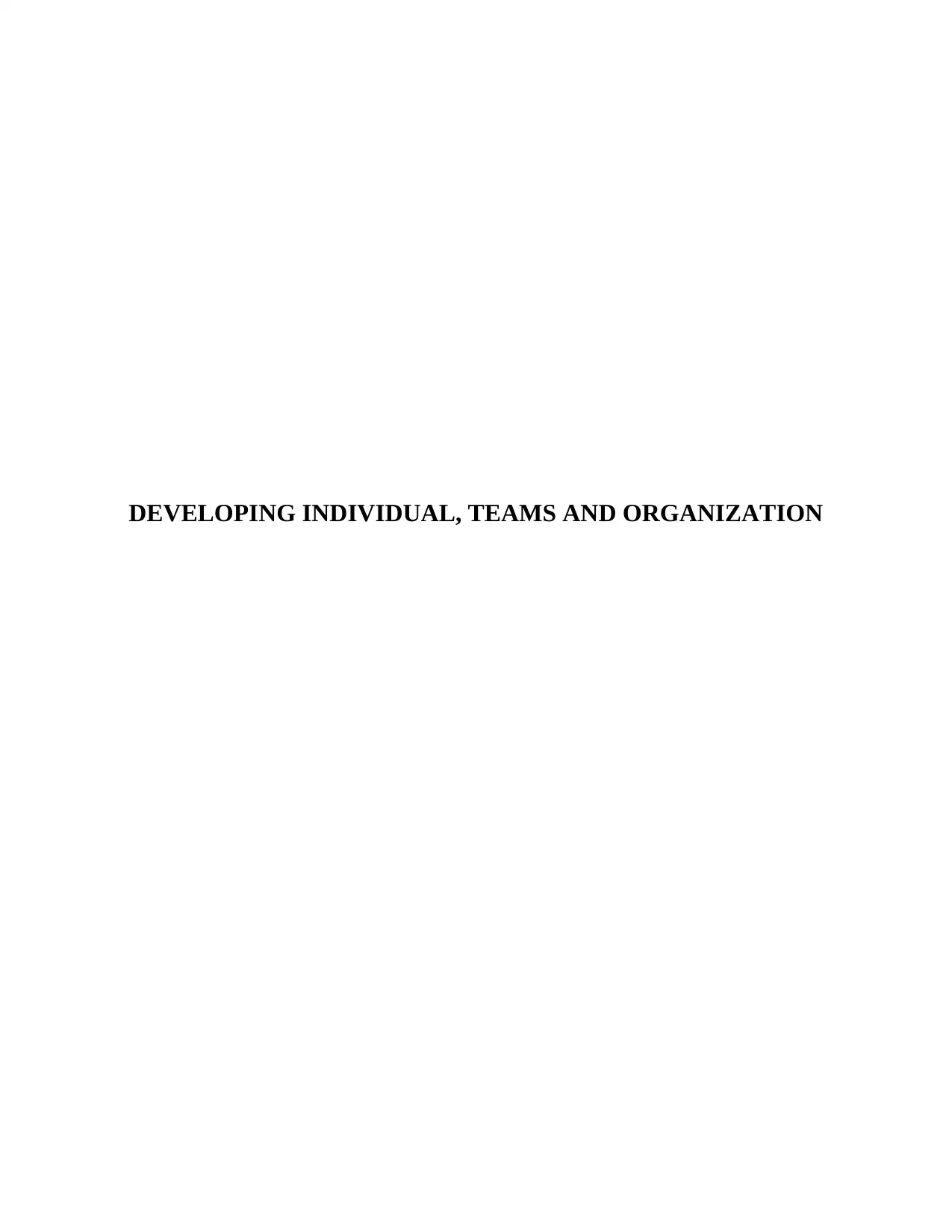
DEVELOPING INDIVIDUAL, TEAMS AND ORGANIZATION
Paraphrase This Document
Need a fresh take? Get an instant paraphrase of this document with our AI Paraphraser
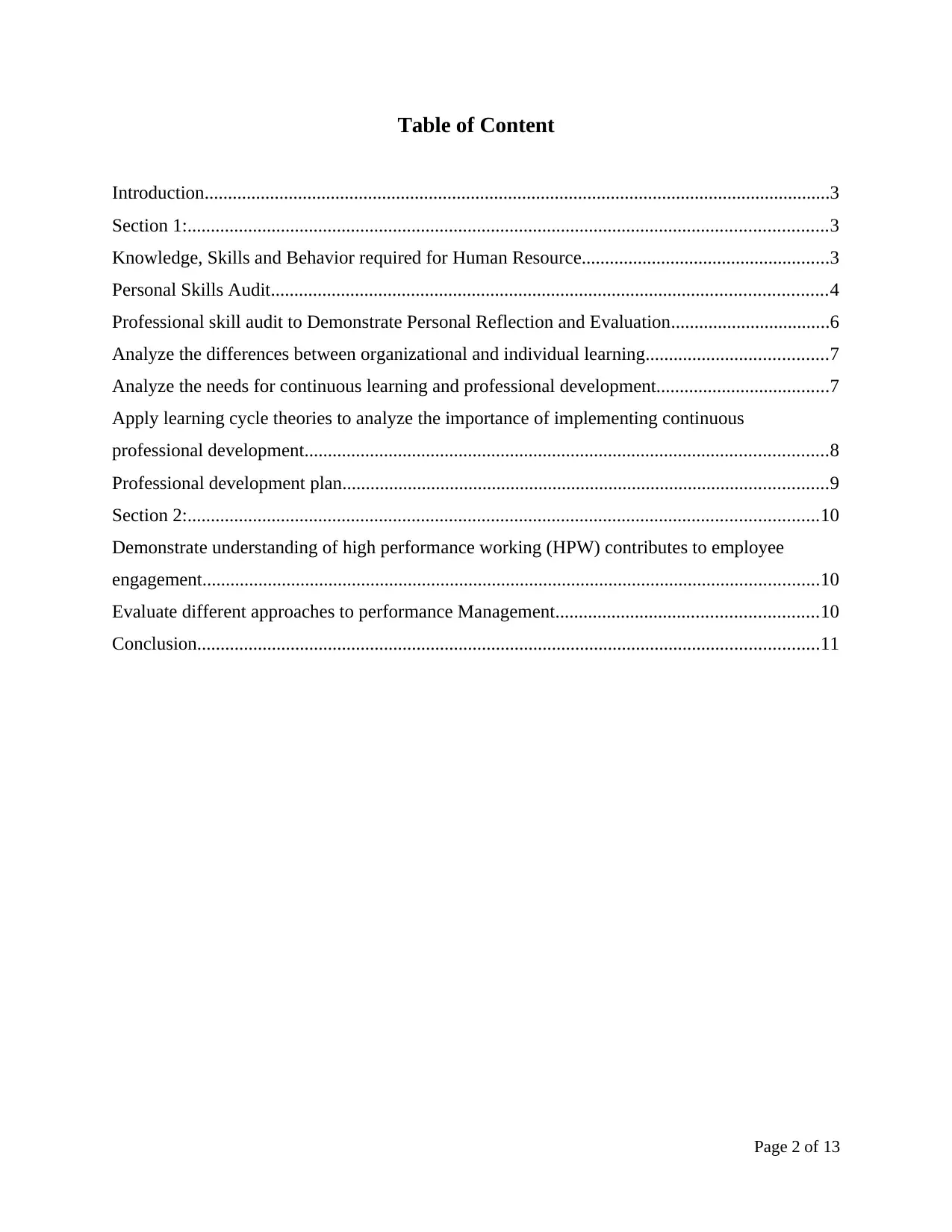
Table of Content
Introduction......................................................................................................................................3
Section 1:.........................................................................................................................................3
Knowledge, Skills and Behavior required for Human Resource.....................................................3
Personal Skills Audit.......................................................................................................................4
Professional skill audit to Demonstrate Personal Reflection and Evaluation..................................6
Analyze the differences between organizational and individual learning.......................................7
Analyze the needs for continuous learning and professional development.....................................7
Apply learning cycle theories to analyze the importance of implementing continuous
professional development................................................................................................................8
Professional development plan........................................................................................................9
Section 2:.......................................................................................................................................10
Demonstrate understanding of high performance working (HPW) contributes to employee
engagement....................................................................................................................................10
Evaluate different approaches to performance Management........................................................10
Conclusion.....................................................................................................................................11
Page 2 of 13
Introduction......................................................................................................................................3
Section 1:.........................................................................................................................................3
Knowledge, Skills and Behavior required for Human Resource.....................................................3
Personal Skills Audit.......................................................................................................................4
Professional skill audit to Demonstrate Personal Reflection and Evaluation..................................6
Analyze the differences between organizational and individual learning.......................................7
Analyze the needs for continuous learning and professional development.....................................7
Apply learning cycle theories to analyze the importance of implementing continuous
professional development................................................................................................................8
Professional development plan........................................................................................................9
Section 2:.......................................................................................................................................10
Demonstrate understanding of high performance working (HPW) contributes to employee
engagement....................................................................................................................................10
Evaluate different approaches to performance Management........................................................10
Conclusion.....................................................................................................................................11
Page 2 of 13
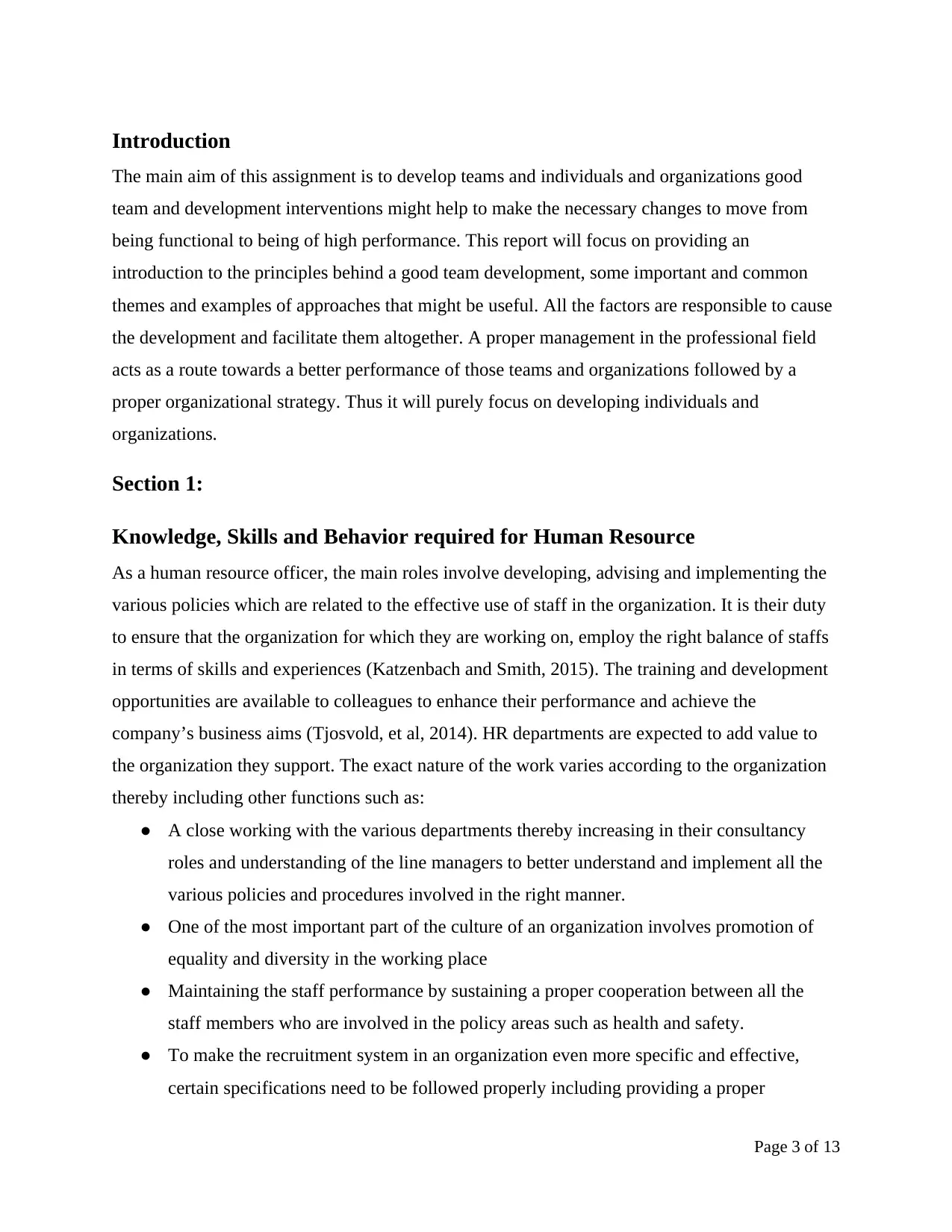
Introduction
The main aim of this assignment is to develop teams and individuals and organizations good
team and development interventions might help to make the necessary changes to move from
being functional to being of high performance. This report will focus on providing an
introduction to the principles behind a good team development, some important and common
themes and examples of approaches that might be useful. All the factors are responsible to cause
the development and facilitate them altogether. A proper management in the professional field
acts as a route towards a better performance of those teams and organizations followed by a
proper organizational strategy. Thus it will purely focus on developing individuals and
organizations.
Section 1:
Knowledge, Skills and Behavior required for Human Resource
As a human resource officer, the main roles involve developing, advising and implementing the
various policies which are related to the effective use of staff in the organization. It is their duty
to ensure that the organization for which they are working on, employ the right balance of staffs
in terms of skills and experiences (Katzenbach and Smith, 2015). The training and development
opportunities are available to colleagues to enhance their performance and achieve the
company’s business aims (Tjosvold, et al, 2014). HR departments are expected to add value to
the organization they support. The exact nature of the work varies according to the organization
thereby including other functions such as:
● A close working with the various departments thereby increasing in their consultancy
roles and understanding of the line managers to better understand and implement all the
various policies and procedures involved in the right manner.
● One of the most important part of the culture of an organization involves promotion of
equality and diversity in the working place
● Maintaining the staff performance by sustaining a proper cooperation between all the
staff members who are involved in the policy areas such as health and safety.
● To make the recruitment system in an organization even more specific and effective,
certain specifications need to be followed properly including providing a proper
Page 3 of 13
The main aim of this assignment is to develop teams and individuals and organizations good
team and development interventions might help to make the necessary changes to move from
being functional to being of high performance. This report will focus on providing an
introduction to the principles behind a good team development, some important and common
themes and examples of approaches that might be useful. All the factors are responsible to cause
the development and facilitate them altogether. A proper management in the professional field
acts as a route towards a better performance of those teams and organizations followed by a
proper organizational strategy. Thus it will purely focus on developing individuals and
organizations.
Section 1:
Knowledge, Skills and Behavior required for Human Resource
As a human resource officer, the main roles involve developing, advising and implementing the
various policies which are related to the effective use of staff in the organization. It is their duty
to ensure that the organization for which they are working on, employ the right balance of staffs
in terms of skills and experiences (Katzenbach and Smith, 2015). The training and development
opportunities are available to colleagues to enhance their performance and achieve the
company’s business aims (Tjosvold, et al, 2014). HR departments are expected to add value to
the organization they support. The exact nature of the work varies according to the organization
thereby including other functions such as:
● A close working with the various departments thereby increasing in their consultancy
roles and understanding of the line managers to better understand and implement all the
various policies and procedures involved in the right manner.
● One of the most important part of the culture of an organization involves promotion of
equality and diversity in the working place
● Maintaining the staff performance by sustaining a proper cooperation between all the
staff members who are involved in the policy areas such as health and safety.
● To make the recruitment system in an organization even more specific and effective,
certain specifications need to be followed properly including providing a proper
Page 3 of 13
⊘ This is a preview!⊘
Do you want full access?
Subscribe today to unlock all pages.

Trusted by 1+ million students worldwide
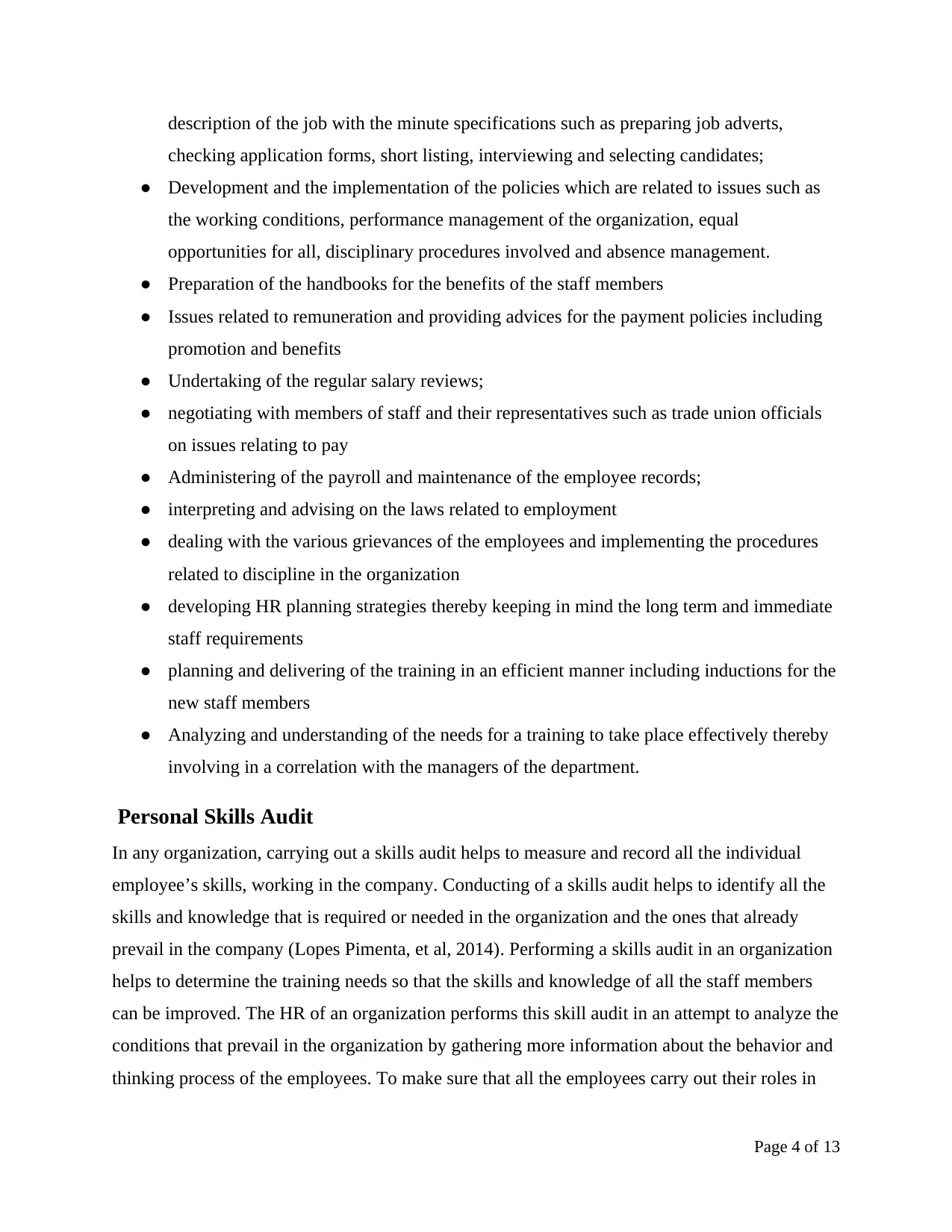
description of the job with the minute specifications such as preparing job adverts,
checking application forms, short listing, interviewing and selecting candidates;
● Development and the implementation of the policies which are related to issues such as
the working conditions, performance management of the organization, equal
opportunities for all, disciplinary procedures involved and absence management.
● Preparation of the handbooks for the benefits of the staff members
● Issues related to remuneration and providing advices for the payment policies including
promotion and benefits
● Undertaking of the regular salary reviews;
● negotiating with members of staff and their representatives such as trade union officials
on issues relating to pay
● Administering of the payroll and maintenance of the employee records;
● interpreting and advising on the laws related to employment
● dealing with the various grievances of the employees and implementing the procedures
related to discipline in the organization
● developing HR planning strategies thereby keeping in mind the long term and immediate
staff requirements
● planning and delivering of the training in an efficient manner including inductions for the
new staff members
● Analyzing and understanding of the needs for a training to take place effectively thereby
involving in a correlation with the managers of the department.
Personal Skills Audit
In any organization, carrying out a skills audit helps to measure and record all the individual
employee’s skills, working in the company. Conducting of a skills audit helps to identify all the
skills and knowledge that is required or needed in the organization and the ones that already
prevail in the company (Lopes Pimenta, et al, 2014). Performing a skills audit in an organization
helps to determine the training needs so that the skills and knowledge of all the staff members
can be improved. The HR of an organization performs this skill audit in an attempt to analyze the
conditions that prevail in the organization by gathering more information about the behavior and
thinking process of the employees. To make sure that all the employees carry out their roles in
Page 4 of 13
checking application forms, short listing, interviewing and selecting candidates;
● Development and the implementation of the policies which are related to issues such as
the working conditions, performance management of the organization, equal
opportunities for all, disciplinary procedures involved and absence management.
● Preparation of the handbooks for the benefits of the staff members
● Issues related to remuneration and providing advices for the payment policies including
promotion and benefits
● Undertaking of the regular salary reviews;
● negotiating with members of staff and their representatives such as trade union officials
on issues relating to pay
● Administering of the payroll and maintenance of the employee records;
● interpreting and advising on the laws related to employment
● dealing with the various grievances of the employees and implementing the procedures
related to discipline in the organization
● developing HR planning strategies thereby keeping in mind the long term and immediate
staff requirements
● planning and delivering of the training in an efficient manner including inductions for the
new staff members
● Analyzing and understanding of the needs for a training to take place effectively thereby
involving in a correlation with the managers of the department.
Personal Skills Audit
In any organization, carrying out a skills audit helps to measure and record all the individual
employee’s skills, working in the company. Conducting of a skills audit helps to identify all the
skills and knowledge that is required or needed in the organization and the ones that already
prevail in the company (Lopes Pimenta, et al, 2014). Performing a skills audit in an organization
helps to determine the training needs so that the skills and knowledge of all the staff members
can be improved. The HR of an organization performs this skill audit in an attempt to analyze the
conditions that prevail in the organization by gathering more information about the behavior and
thinking process of the employees. To make sure that all the employees carry out their roles in
Page 4 of 13
Paraphrase This Document
Need a fresh take? Get an instant paraphrase of this document with our AI Paraphraser
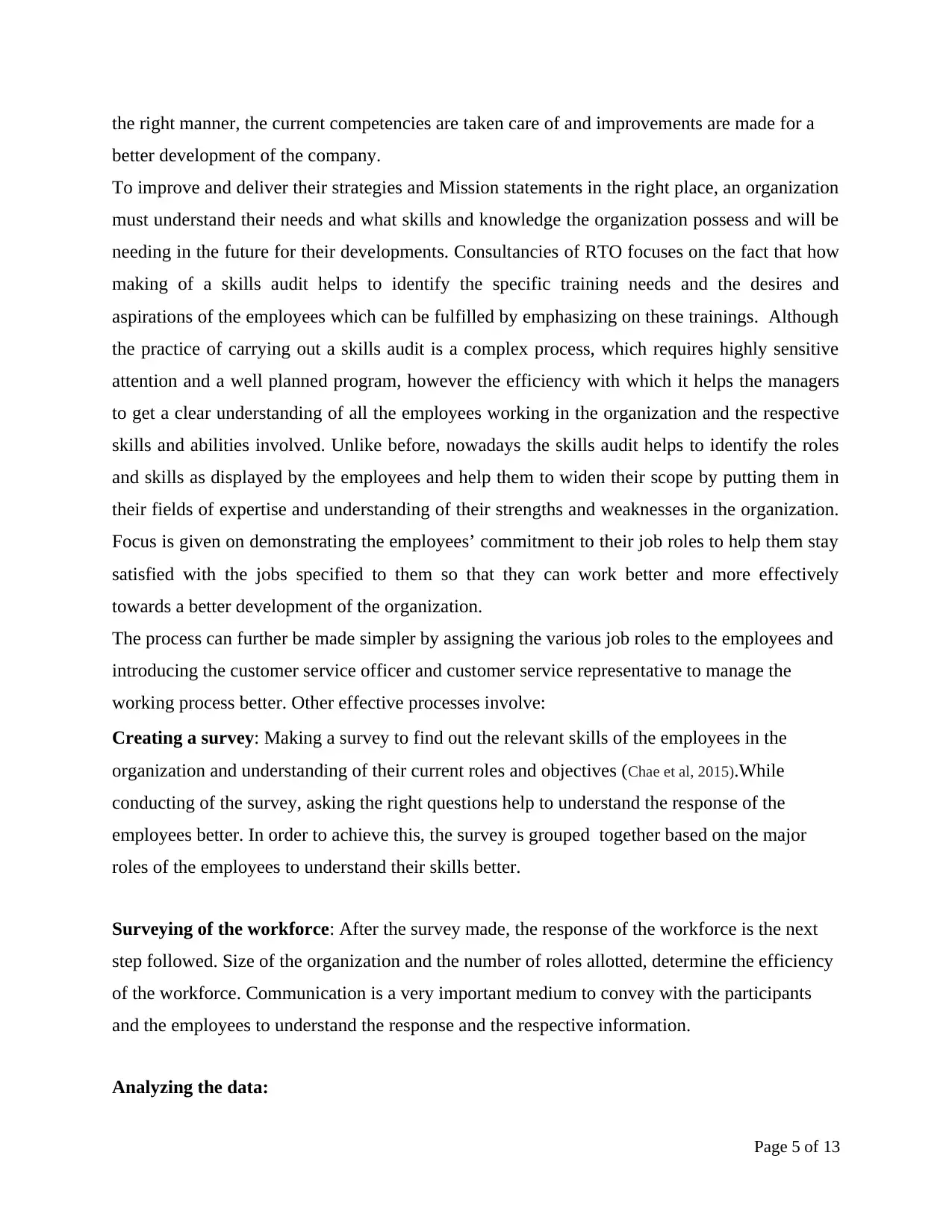
the right manner, the current competencies are taken care of and improvements are made for a
better development of the company.
To improve and deliver their strategies and Mission statements in the right place, an organization
must understand their needs and what skills and knowledge the organization possess and will be
needing in the future for their developments. Consultancies of RTO focuses on the fact that how
making of a skills audit helps to identify the specific training needs and the desires and
aspirations of the employees which can be fulfilled by emphasizing on these trainings. Although
the practice of carrying out a skills audit is a complex process, which requires highly sensitive
attention and a well planned program, however the efficiency with which it helps the managers
to get a clear understanding of all the employees working in the organization and the respective
skills and abilities involved. Unlike before, nowadays the skills audit helps to identify the roles
and skills as displayed by the employees and help them to widen their scope by putting them in
their fields of expertise and understanding of their strengths and weaknesses in the organization.
Focus is given on demonstrating the employees’ commitment to their job roles to help them stay
satisfied with the jobs specified to them so that they can work better and more effectively
towards a better development of the organization.
The process can further be made simpler by assigning the various job roles to the employees and
introducing the customer service officer and customer service representative to manage the
working process better. Other effective processes involve:
Creating a survey: Making a survey to find out the relevant skills of the employees in the
organization and understanding of their current roles and objectives (Chae et al, 2015).While
conducting of the survey, asking the right questions help to understand the response of the
employees better. In order to achieve this, the survey is grouped together based on the major
roles of the employees to understand their skills better.
Surveying of the workforce: After the survey made, the response of the workforce is the next
step followed. Size of the organization and the number of roles allotted, determine the efficiency
of the workforce. Communication is a very important medium to convey with the participants
and the employees to understand the response and the respective information.
Analyzing the data:
Page 5 of 13
better development of the company.
To improve and deliver their strategies and Mission statements in the right place, an organization
must understand their needs and what skills and knowledge the organization possess and will be
needing in the future for their developments. Consultancies of RTO focuses on the fact that how
making of a skills audit helps to identify the specific training needs and the desires and
aspirations of the employees which can be fulfilled by emphasizing on these trainings. Although
the practice of carrying out a skills audit is a complex process, which requires highly sensitive
attention and a well planned program, however the efficiency with which it helps the managers
to get a clear understanding of all the employees working in the organization and the respective
skills and abilities involved. Unlike before, nowadays the skills audit helps to identify the roles
and skills as displayed by the employees and help them to widen their scope by putting them in
their fields of expertise and understanding of their strengths and weaknesses in the organization.
Focus is given on demonstrating the employees’ commitment to their job roles to help them stay
satisfied with the jobs specified to them so that they can work better and more effectively
towards a better development of the organization.
The process can further be made simpler by assigning the various job roles to the employees and
introducing the customer service officer and customer service representative to manage the
working process better. Other effective processes involve:
Creating a survey: Making a survey to find out the relevant skills of the employees in the
organization and understanding of their current roles and objectives (Chae et al, 2015).While
conducting of the survey, asking the right questions help to understand the response of the
employees better. In order to achieve this, the survey is grouped together based on the major
roles of the employees to understand their skills better.
Surveying of the workforce: After the survey made, the response of the workforce is the next
step followed. Size of the organization and the number of roles allotted, determine the efficiency
of the workforce. Communication is a very important medium to convey with the participants
and the employees to understand the response and the respective information.
Analyzing the data:
Page 5 of 13
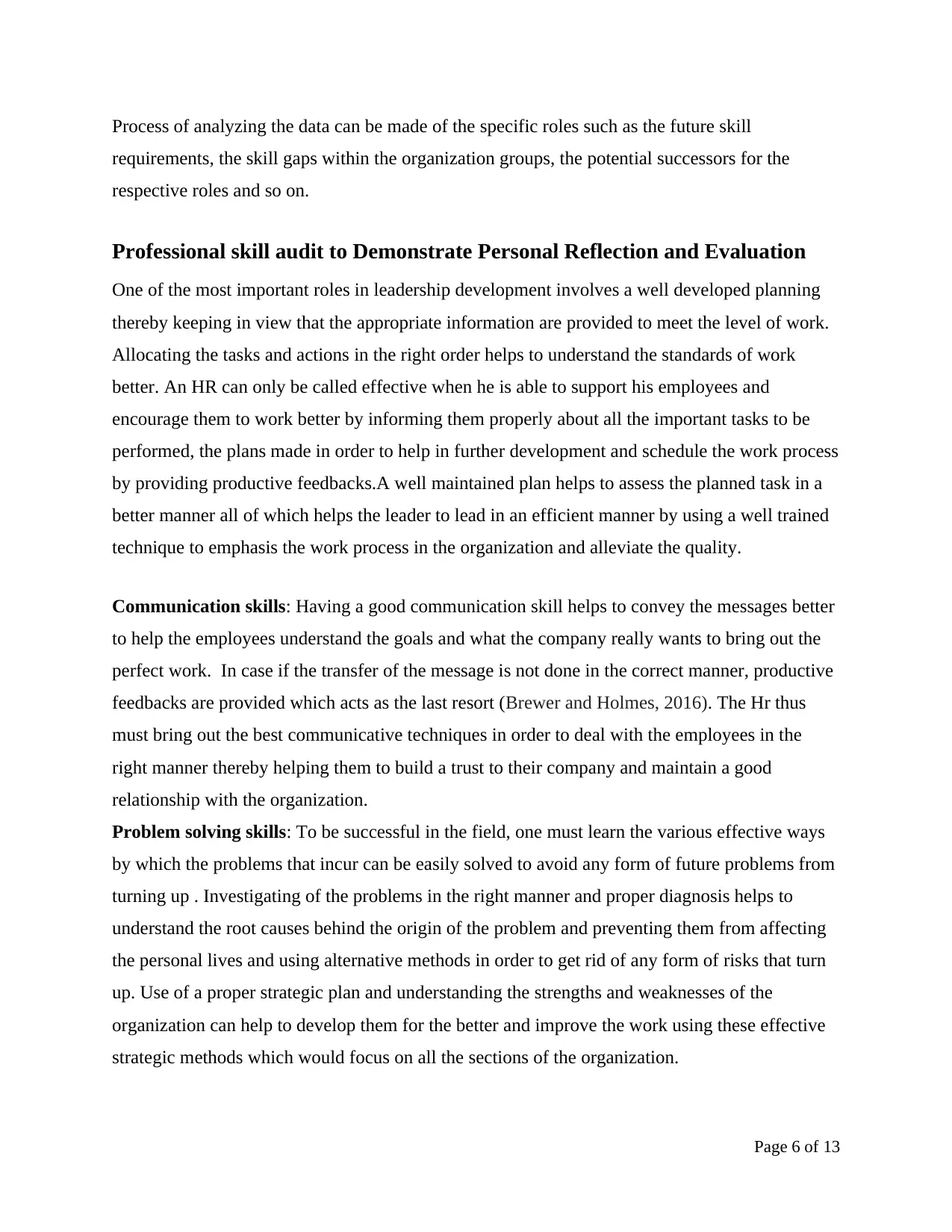
Process of analyzing the data can be made of the specific roles such as the future skill
requirements, the skill gaps within the organization groups, the potential successors for the
respective roles and so on.
Professional skill audit to Demonstrate Personal Reflection and Evaluation
One of the most important roles in leadership development involves a well developed planning
thereby keeping in view that the appropriate information are provided to meet the level of work.
Allocating the tasks and actions in the right order helps to understand the standards of work
better. An HR can only be called effective when he is able to support his employees and
encourage them to work better by informing them properly about all the important tasks to be
performed, the plans made in order to help in further development and schedule the work process
by providing productive feedbacks.A well maintained plan helps to assess the planned task in a
better manner all of which helps the leader to lead in an efficient manner by using a well trained
technique to emphasis the work process in the organization and alleviate the quality.
Communication skills: Having a good communication skill helps to convey the messages better
to help the employees understand the goals and what the company really wants to bring out the
perfect work. In case if the transfer of the message is not done in the correct manner, productive
feedbacks are provided which acts as the last resort (Brewer and Holmes, 2016). The Hr thus
must bring out the best communicative techniques in order to deal with the employees in the
right manner thereby helping them to build a trust to their company and maintain a good
relationship with the organization.
Problem solving skills: To be successful in the field, one must learn the various effective ways
by which the problems that incur can be easily solved to avoid any form of future problems from
turning up . Investigating of the problems in the right manner and proper diagnosis helps to
understand the root causes behind the origin of the problem and preventing them from affecting
the personal lives and using alternative methods in order to get rid of any form of risks that turn
up. Use of a proper strategic plan and understanding the strengths and weaknesses of the
organization can help to develop them for the better and improve the work using these effective
strategic methods which would focus on all the sections of the organization.
Page 6 of 13
requirements, the skill gaps within the organization groups, the potential successors for the
respective roles and so on.
Professional skill audit to Demonstrate Personal Reflection and Evaluation
One of the most important roles in leadership development involves a well developed planning
thereby keeping in view that the appropriate information are provided to meet the level of work.
Allocating the tasks and actions in the right order helps to understand the standards of work
better. An HR can only be called effective when he is able to support his employees and
encourage them to work better by informing them properly about all the important tasks to be
performed, the plans made in order to help in further development and schedule the work process
by providing productive feedbacks.A well maintained plan helps to assess the planned task in a
better manner all of which helps the leader to lead in an efficient manner by using a well trained
technique to emphasis the work process in the organization and alleviate the quality.
Communication skills: Having a good communication skill helps to convey the messages better
to help the employees understand the goals and what the company really wants to bring out the
perfect work. In case if the transfer of the message is not done in the correct manner, productive
feedbacks are provided which acts as the last resort (Brewer and Holmes, 2016). The Hr thus
must bring out the best communicative techniques in order to deal with the employees in the
right manner thereby helping them to build a trust to their company and maintain a good
relationship with the organization.
Problem solving skills: To be successful in the field, one must learn the various effective ways
by which the problems that incur can be easily solved to avoid any form of future problems from
turning up . Investigating of the problems in the right manner and proper diagnosis helps to
understand the root causes behind the origin of the problem and preventing them from affecting
the personal lives and using alternative methods in order to get rid of any form of risks that turn
up. Use of a proper strategic plan and understanding the strengths and weaknesses of the
organization can help to develop them for the better and improve the work using these effective
strategic methods which would focus on all the sections of the organization.
Page 6 of 13
⊘ This is a preview!⊘
Do you want full access?
Subscribe today to unlock all pages.

Trusted by 1+ million students worldwide
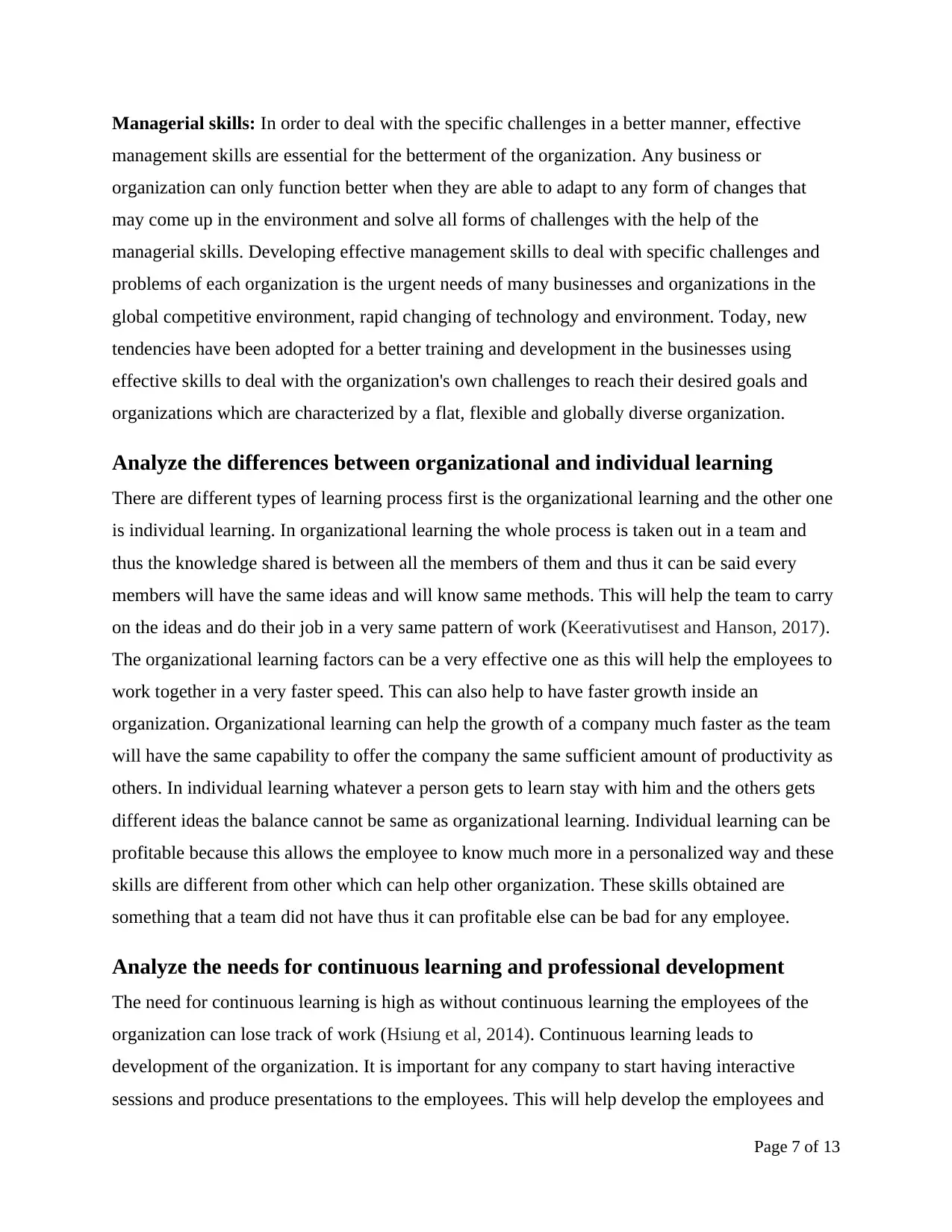
Managerial skills: In order to deal with the specific challenges in a better manner, effective
management skills are essential for the betterment of the organization. Any business or
organization can only function better when they are able to adapt to any form of changes that
may come up in the environment and solve all forms of challenges with the help of the
managerial skills. Developing effective management skills to deal with specific challenges and
problems of each organization is the urgent needs of many businesses and organizations in the
global competitive environment, rapid changing of technology and environment. Today, new
tendencies have been adopted for a better training and development in the businesses using
effective skills to deal with the organization's own challenges to reach their desired goals and
organizations which are characterized by a flat, flexible and globally diverse organization.
Analyze the differences between organizational and individual learning
There are different types of learning process first is the organizational learning and the other one
is individual learning. In organizational learning the whole process is taken out in a team and
thus the knowledge shared is between all the members of them and thus it can be said every
members will have the same ideas and will know same methods. This will help the team to carry
on the ideas and do their job in a very same pattern of work (Keerativutisest and Hanson, 2017).
The organizational learning factors can be a very effective one as this will help the employees to
work together in a very faster speed. This can also help to have faster growth inside an
organization. Organizational learning can help the growth of a company much faster as the team
will have the same capability to offer the company the same sufficient amount of productivity as
others. In individual learning whatever a person gets to learn stay with him and the others gets
different ideas the balance cannot be same as organizational learning. Individual learning can be
profitable because this allows the employee to know much more in a personalized way and these
skills are different from other which can help other organization. These skills obtained are
something that a team did not have thus it can profitable else can be bad for any employee.
Analyze the needs for continuous learning and professional development
The need for continuous learning is high as without continuous learning the employees of the
organization can lose track of work (Hsiung et al, 2014). Continuous learning leads to
development of the organization. It is important for any company to start having interactive
sessions and produce presentations to the employees. This will help develop the employees and
Page 7 of 13
management skills are essential for the betterment of the organization. Any business or
organization can only function better when they are able to adapt to any form of changes that
may come up in the environment and solve all forms of challenges with the help of the
managerial skills. Developing effective management skills to deal with specific challenges and
problems of each organization is the urgent needs of many businesses and organizations in the
global competitive environment, rapid changing of technology and environment. Today, new
tendencies have been adopted for a better training and development in the businesses using
effective skills to deal with the organization's own challenges to reach their desired goals and
organizations which are characterized by a flat, flexible and globally diverse organization.
Analyze the differences between organizational and individual learning
There are different types of learning process first is the organizational learning and the other one
is individual learning. In organizational learning the whole process is taken out in a team and
thus the knowledge shared is between all the members of them and thus it can be said every
members will have the same ideas and will know same methods. This will help the team to carry
on the ideas and do their job in a very same pattern of work (Keerativutisest and Hanson, 2017).
The organizational learning factors can be a very effective one as this will help the employees to
work together in a very faster speed. This can also help to have faster growth inside an
organization. Organizational learning can help the growth of a company much faster as the team
will have the same capability to offer the company the same sufficient amount of productivity as
others. In individual learning whatever a person gets to learn stay with him and the others gets
different ideas the balance cannot be same as organizational learning. Individual learning can be
profitable because this allows the employee to know much more in a personalized way and these
skills are different from other which can help other organization. These skills obtained are
something that a team did not have thus it can profitable else can be bad for any employee.
Analyze the needs for continuous learning and professional development
The need for continuous learning is high as without continuous learning the employees of the
organization can lose track of work (Hsiung et al, 2014). Continuous learning leads to
development of the organization. It is important for any company to start having interactive
sessions and produce presentations to the employees. This will help develop the employees and
Page 7 of 13
Paraphrase This Document
Need a fresh take? Get an instant paraphrase of this document with our AI Paraphraser
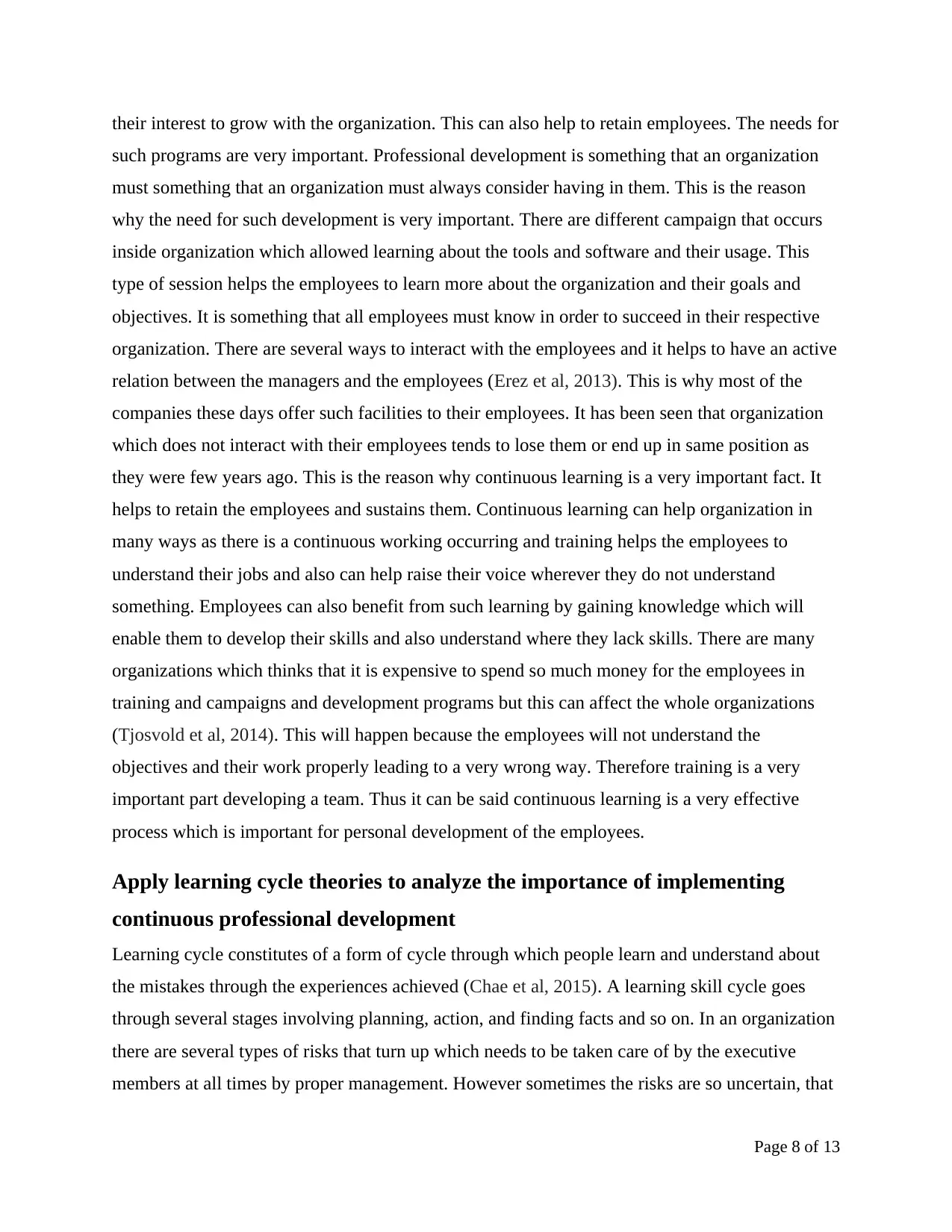
their interest to grow with the organization. This can also help to retain employees. The needs for
such programs are very important. Professional development is something that an organization
must something that an organization must always consider having in them. This is the reason
why the need for such development is very important. There are different campaign that occurs
inside organization which allowed learning about the tools and software and their usage. This
type of session helps the employees to learn more about the organization and their goals and
objectives. It is something that all employees must know in order to succeed in their respective
organization. There are several ways to interact with the employees and it helps to have an active
relation between the managers and the employees (Erez et al, 2013). This is why most of the
companies these days offer such facilities to their employees. It has been seen that organization
which does not interact with their employees tends to lose them or end up in same position as
they were few years ago. This is the reason why continuous learning is a very important fact. It
helps to retain the employees and sustains them. Continuous learning can help organization in
many ways as there is a continuous working occurring and training helps the employees to
understand their jobs and also can help raise their voice wherever they do not understand
something. Employees can also benefit from such learning by gaining knowledge which will
enable them to develop their skills and also understand where they lack skills. There are many
organizations which thinks that it is expensive to spend so much money for the employees in
training and campaigns and development programs but this can affect the whole organizations
(Tjosvold et al, 2014). This will happen because the employees will not understand the
objectives and their work properly leading to a very wrong way. Therefore training is a very
important part developing a team. Thus it can be said continuous learning is a very effective
process which is important for personal development of the employees.
Apply learning cycle theories to analyze the importance of implementing
continuous professional development
Learning cycle constitutes of a form of cycle through which people learn and understand about
the mistakes through the experiences achieved (Chae et al, 2015). A learning skill cycle goes
through several stages involving planning, action, and finding facts and so on. In an organization
there are several types of risks that turn up which needs to be taken care of by the executive
members at all times by proper management. However sometimes the risks are so uncertain, that
Page 8 of 13
such programs are very important. Professional development is something that an organization
must something that an organization must always consider having in them. This is the reason
why the need for such development is very important. There are different campaign that occurs
inside organization which allowed learning about the tools and software and their usage. This
type of session helps the employees to learn more about the organization and their goals and
objectives. It is something that all employees must know in order to succeed in their respective
organization. There are several ways to interact with the employees and it helps to have an active
relation between the managers and the employees (Erez et al, 2013). This is why most of the
companies these days offer such facilities to their employees. It has been seen that organization
which does not interact with their employees tends to lose them or end up in same position as
they were few years ago. This is the reason why continuous learning is a very important fact. It
helps to retain the employees and sustains them. Continuous learning can help organization in
many ways as there is a continuous working occurring and training helps the employees to
understand their jobs and also can help raise their voice wherever they do not understand
something. Employees can also benefit from such learning by gaining knowledge which will
enable them to develop their skills and also understand where they lack skills. There are many
organizations which thinks that it is expensive to spend so much money for the employees in
training and campaigns and development programs but this can affect the whole organizations
(Tjosvold et al, 2014). This will happen because the employees will not understand the
objectives and their work properly leading to a very wrong way. Therefore training is a very
important part developing a team. Thus it can be said continuous learning is a very effective
process which is important for personal development of the employees.
Apply learning cycle theories to analyze the importance of implementing
continuous professional development
Learning cycle constitutes of a form of cycle through which people learn and understand about
the mistakes through the experiences achieved (Chae et al, 2015). A learning skill cycle goes
through several stages involving planning, action, and finding facts and so on. In an organization
there are several types of risks that turn up which needs to be taken care of by the executive
members at all times by proper management. However sometimes the risks are so uncertain, that
Page 8 of 13
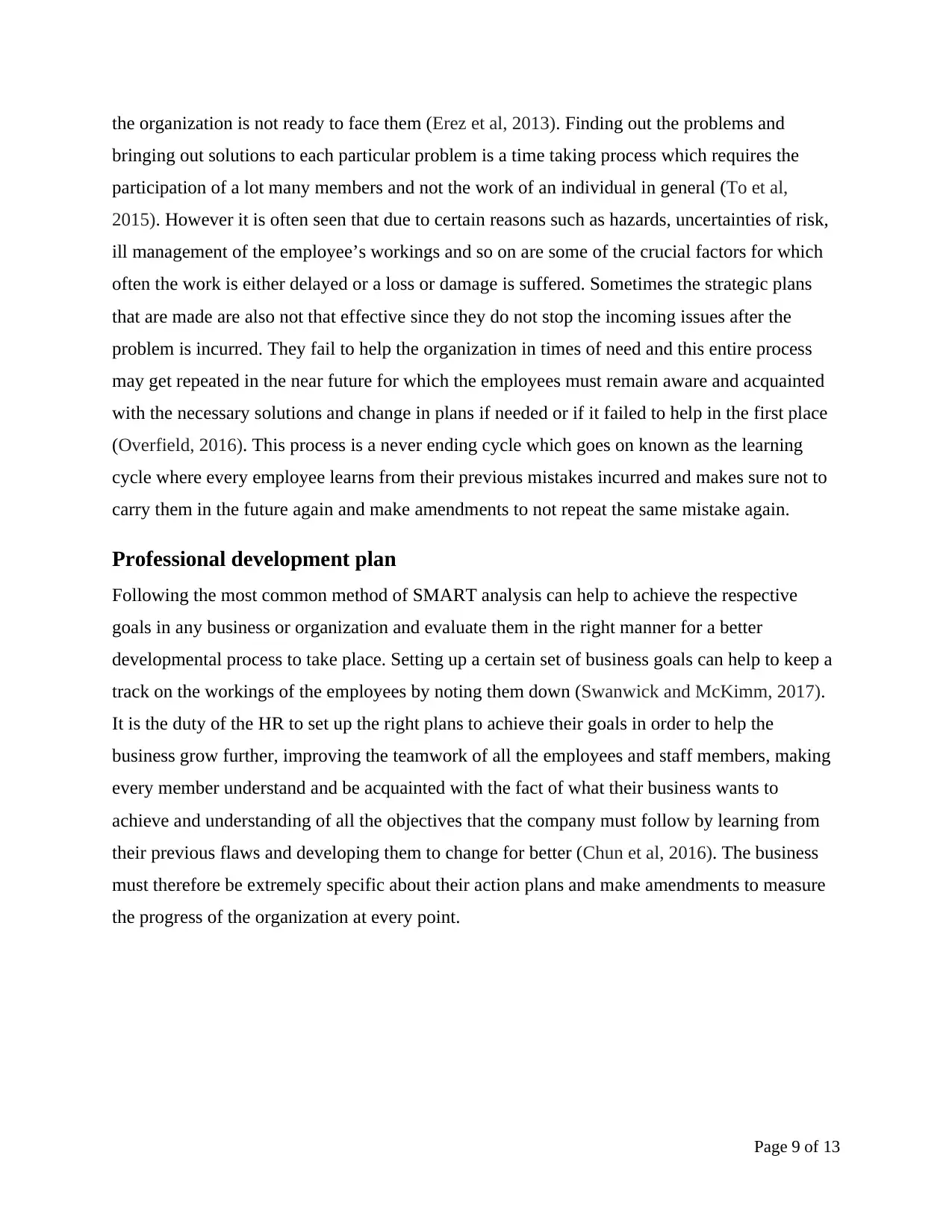
the organization is not ready to face them (Erez et al, 2013). Finding out the problems and
bringing out solutions to each particular problem is a time taking process which requires the
participation of a lot many members and not the work of an individual in general (To et al,
2015). However it is often seen that due to certain reasons such as hazards, uncertainties of risk,
ill management of the employee’s workings and so on are some of the crucial factors for which
often the work is either delayed or a loss or damage is suffered. Sometimes the strategic plans
that are made are also not that effective since they do not stop the incoming issues after the
problem is incurred. They fail to help the organization in times of need and this entire process
may get repeated in the near future for which the employees must remain aware and acquainted
with the necessary solutions and change in plans if needed or if it failed to help in the first place
(Overfield, 2016). This process is a never ending cycle which goes on known as the learning
cycle where every employee learns from their previous mistakes incurred and makes sure not to
carry them in the future again and make amendments to not repeat the same mistake again.
Professional development plan
Following the most common method of SMART analysis can help to achieve the respective
goals in any business or organization and evaluate them in the right manner for a better
developmental process to take place. Setting up a certain set of business goals can help to keep a
track on the workings of the employees by noting them down (Swanwick and McKimm, 2017).
It is the duty of the HR to set up the right plans to achieve their goals in order to help the
business grow further, improving the teamwork of all the employees and staff members, making
every member understand and be acquainted with the fact of what their business wants to
achieve and understanding of all the objectives that the company must follow by learning from
their previous flaws and developing them to change for better (Chun et al, 2016). The business
must therefore be extremely specific about their action plans and make amendments to measure
the progress of the organization at every point.
Page 9 of 13
bringing out solutions to each particular problem is a time taking process which requires the
participation of a lot many members and not the work of an individual in general (To et al,
2015). However it is often seen that due to certain reasons such as hazards, uncertainties of risk,
ill management of the employee’s workings and so on are some of the crucial factors for which
often the work is either delayed or a loss or damage is suffered. Sometimes the strategic plans
that are made are also not that effective since they do not stop the incoming issues after the
problem is incurred. They fail to help the organization in times of need and this entire process
may get repeated in the near future for which the employees must remain aware and acquainted
with the necessary solutions and change in plans if needed or if it failed to help in the first place
(Overfield, 2016). This process is a never ending cycle which goes on known as the learning
cycle where every employee learns from their previous mistakes incurred and makes sure not to
carry them in the future again and make amendments to not repeat the same mistake again.
Professional development plan
Following the most common method of SMART analysis can help to achieve the respective
goals in any business or organization and evaluate them in the right manner for a better
developmental process to take place. Setting up a certain set of business goals can help to keep a
track on the workings of the employees by noting them down (Swanwick and McKimm, 2017).
It is the duty of the HR to set up the right plans to achieve their goals in order to help the
business grow further, improving the teamwork of all the employees and staff members, making
every member understand and be acquainted with the fact of what their business wants to
achieve and understanding of all the objectives that the company must follow by learning from
their previous flaws and developing them to change for better (Chun et al, 2016). The business
must therefore be extremely specific about their action plans and make amendments to measure
the progress of the organization at every point.
Page 9 of 13
⊘ This is a preview!⊘
Do you want full access?
Subscribe today to unlock all pages.

Trusted by 1+ million students worldwide

Section 2:
Demonstrate understanding of high performance working (HPW) contributes
to employee engagement
It is worth saying that, high performance activity is all about to create culture so that, the
workplace environment becomes transparent and employees can communicate with each other
openly. The ultimate objective of any organization s to create corporate awareness among the
employees so that, it will be possible for the company to have business growth in terms of
financial profitability. For this purpose, it is necessary for each of the company to erode the
traditional hierarchical structure so that, it will be helpful for the employees to engage with the
tasks by developing networking. There are various studies that state that, HPW involves some of
the key factors and those are high employee involvement, human resource practices and the other
one is all about the reward and commitment practices. Therefore, is worth noting that, the high
performance working will be effective when business ventures use this HPW model along with
the aforementioned factors. This is because, without having high employee engagement it will
not be possible for the companies to retain customer and gain competitive advantage within the
intense competitive business world (Overfield, 2016). Therefore, under this model, each of the
companies should have to allow employee to share their own knowledge and ideas to make the
workplace environment better. High performing teams have that potential to develop their own
set characteristics so that they become able to take decisions about the company. Aside from this,
high performing teams hold high levels of motivation, energy and satisfaction and therefore, it is
not necessary for the company to investment more funds to make them motivated.
Evaluate different approaches to performance Management
There are different approaches of performance management as the need of increasing the
management speed is high. It is important to evaluate the performance the management speed.
There many ways to create a better performance management program as it an important part of
the organization. The employees have to enhance themselves for the betterment of the
organization and this is needed because without the growth of the organization it is not worth
working in that organization. It is important to have different approaches towards performance
management because this would enable the employees to have a better approach towards the job.
It can also help the organization to make more profit and develop itself in the bigger platform.
Page 10 of 13
Demonstrate understanding of high performance working (HPW) contributes
to employee engagement
It is worth saying that, high performance activity is all about to create culture so that, the
workplace environment becomes transparent and employees can communicate with each other
openly. The ultimate objective of any organization s to create corporate awareness among the
employees so that, it will be possible for the company to have business growth in terms of
financial profitability. For this purpose, it is necessary for each of the company to erode the
traditional hierarchical structure so that, it will be helpful for the employees to engage with the
tasks by developing networking. There are various studies that state that, HPW involves some of
the key factors and those are high employee involvement, human resource practices and the other
one is all about the reward and commitment practices. Therefore, is worth noting that, the high
performance working will be effective when business ventures use this HPW model along with
the aforementioned factors. This is because, without having high employee engagement it will
not be possible for the companies to retain customer and gain competitive advantage within the
intense competitive business world (Overfield, 2016). Therefore, under this model, each of the
companies should have to allow employee to share their own knowledge and ideas to make the
workplace environment better. High performing teams have that potential to develop their own
set characteristics so that they become able to take decisions about the company. Aside from this,
high performing teams hold high levels of motivation, energy and satisfaction and therefore, it is
not necessary for the company to investment more funds to make them motivated.
Evaluate different approaches to performance Management
There are different approaches of performance management as the need of increasing the
management speed is high. It is important to evaluate the performance the management speed.
There many ways to create a better performance management program as it an important part of
the organization. The employees have to enhance themselves for the betterment of the
organization and this is needed because without the growth of the organization it is not worth
working in that organization. It is important to have different approaches towards performance
management because this would enable the employees to have a better approach towards the job.
It can also help the organization to make more profit and develop itself in the bigger platform.
Page 10 of 13
Paraphrase This Document
Need a fresh take? Get an instant paraphrase of this document with our AI Paraphraser
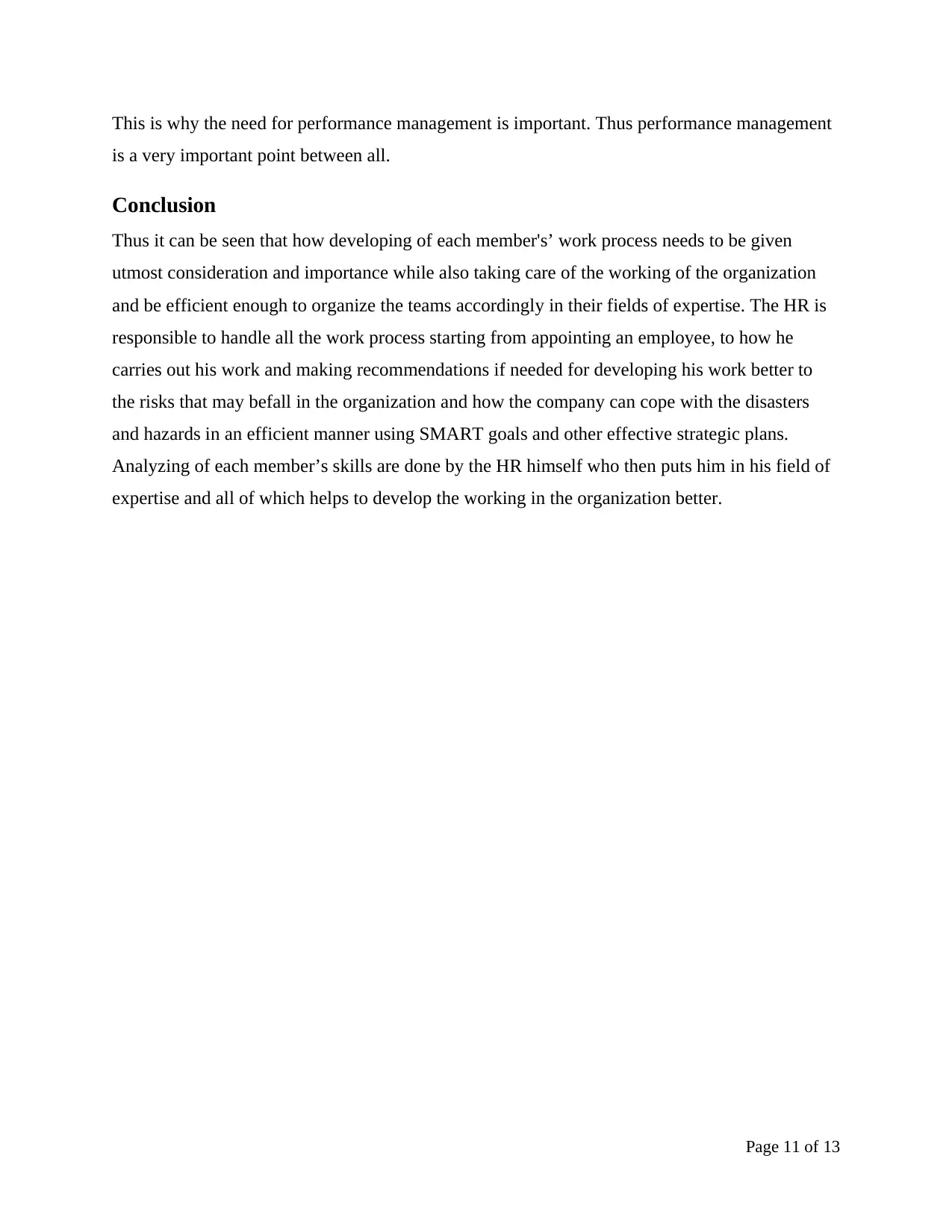
This is why the need for performance management is important. Thus performance management
is a very important point between all.
Conclusion
Thus it can be seen that how developing of each member's’ work process needs to be given
utmost consideration and importance while also taking care of the working of the organization
and be efficient enough to organize the teams accordingly in their fields of expertise. The HR is
responsible to handle all the work process starting from appointing an employee, to how he
carries out his work and making recommendations if needed for developing his work better to
the risks that may befall in the organization and how the company can cope with the disasters
and hazards in an efficient manner using SMART goals and other effective strategic plans.
Analyzing of each member’s skills are done by the HR himself who then puts him in his field of
expertise and all of which helps to develop the working in the organization better.
Page 11 of 13
is a very important point between all.
Conclusion
Thus it can be seen that how developing of each member's’ work process needs to be given
utmost consideration and importance while also taking care of the working of the organization
and be efficient enough to organize the teams accordingly in their fields of expertise. The HR is
responsible to handle all the work process starting from appointing an employee, to how he
carries out his work and making recommendations if needed for developing his work better to
the risks that may befall in the organization and how the company can cope with the disasters
and hazards in an efficient manner using SMART goals and other effective strategic plans.
Analyzing of each member’s skills are done by the HR himself who then puts him in his field of
expertise and all of which helps to develop the working in the organization better.
Page 11 of 13
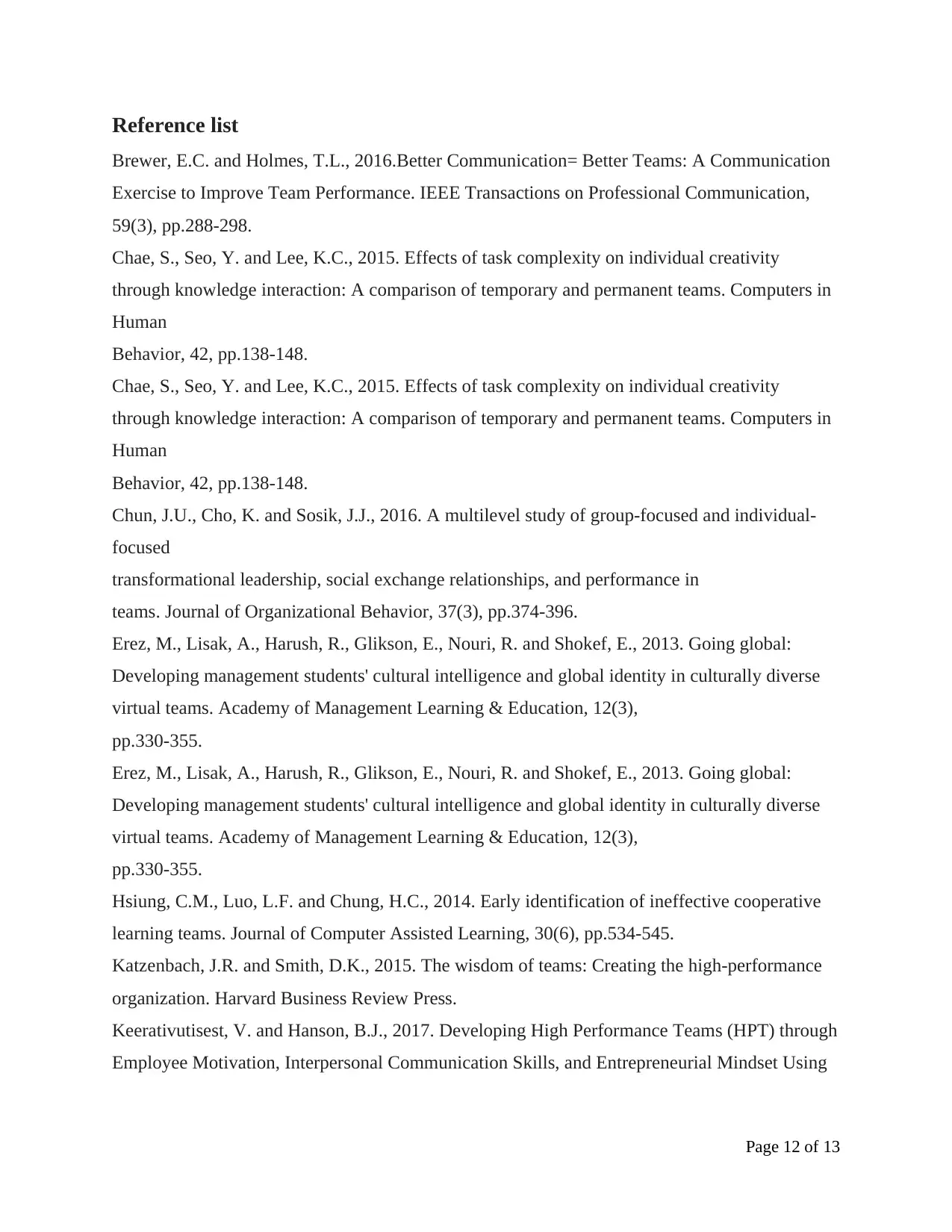
Reference list
Brewer, E.C. and Holmes, T.L., 2016.Better Communication= Better Teams: A Communication
Exercise to Improve Team Performance. IEEE Transactions on Professional Communication,
59(3), pp.288-298.
Chae, S., Seo, Y. and Lee, K.C., 2015. Effects of task complexity on individual creativity
through knowledge interaction: A comparison of temporary and permanent teams. Computers in
Human
Behavior, 42, pp.138-148.
Chae, S., Seo, Y. and Lee, K.C., 2015. Effects of task complexity on individual creativity
through knowledge interaction: A comparison of temporary and permanent teams. Computers in
Human
Behavior, 42, pp.138-148.
Chun, J.U., Cho, K. and Sosik, J.J., 2016. A multilevel study of group‐focused and individual‐
focused
transformational leadership, social exchange relationships, and performance in
teams. Journal of Organizational Behavior, 37(3), pp.374-396.
Erez, M., Lisak, A., Harush, R., Glikson, E., Nouri, R. and Shokef, E., 2013. Going global:
Developing management students' cultural intelligence and global identity in culturally diverse
virtual teams. Academy of Management Learning & Education, 12(3),
pp.330-355.
Erez, M., Lisak, A., Harush, R., Glikson, E., Nouri, R. and Shokef, E., 2013. Going global:
Developing management students' cultural intelligence and global identity in culturally diverse
virtual teams. Academy of Management Learning & Education, 12(3),
pp.330-355.
Hsiung, C.M., Luo, L.F. and Chung, H.C., 2014. Early identification of ineffective cooperative
learning teams. Journal of Computer Assisted Learning, 30(6), pp.534-545.
Katzenbach, J.R. and Smith, D.K., 2015. The wisdom of teams: Creating the high-performance
organization. Harvard Business Review Press.
Keerativutisest, V. and Hanson, B.J., 2017. Developing High Performance Teams (HPT) through
Employee Motivation, Interpersonal Communication Skills, and Entrepreneurial Mindset Using
Page 12 of 13
Brewer, E.C. and Holmes, T.L., 2016.Better Communication= Better Teams: A Communication
Exercise to Improve Team Performance. IEEE Transactions on Professional Communication,
59(3), pp.288-298.
Chae, S., Seo, Y. and Lee, K.C., 2015. Effects of task complexity on individual creativity
through knowledge interaction: A comparison of temporary and permanent teams. Computers in
Human
Behavior, 42, pp.138-148.
Chae, S., Seo, Y. and Lee, K.C., 2015. Effects of task complexity on individual creativity
through knowledge interaction: A comparison of temporary and permanent teams. Computers in
Human
Behavior, 42, pp.138-148.
Chun, J.U., Cho, K. and Sosik, J.J., 2016. A multilevel study of group‐focused and individual‐
focused
transformational leadership, social exchange relationships, and performance in
teams. Journal of Organizational Behavior, 37(3), pp.374-396.
Erez, M., Lisak, A., Harush, R., Glikson, E., Nouri, R. and Shokef, E., 2013. Going global:
Developing management students' cultural intelligence and global identity in culturally diverse
virtual teams. Academy of Management Learning & Education, 12(3),
pp.330-355.
Erez, M., Lisak, A., Harush, R., Glikson, E., Nouri, R. and Shokef, E., 2013. Going global:
Developing management students' cultural intelligence and global identity in culturally diverse
virtual teams. Academy of Management Learning & Education, 12(3),
pp.330-355.
Hsiung, C.M., Luo, L.F. and Chung, H.C., 2014. Early identification of ineffective cooperative
learning teams. Journal of Computer Assisted Learning, 30(6), pp.534-545.
Katzenbach, J.R. and Smith, D.K., 2015. The wisdom of teams: Creating the high-performance
organization. Harvard Business Review Press.
Keerativutisest, V. and Hanson, B.J., 2017. Developing High Performance Teams (HPT) through
Employee Motivation, Interpersonal Communication Skills, and Entrepreneurial Mindset Using
Page 12 of 13
⊘ This is a preview!⊘
Do you want full access?
Subscribe today to unlock all pages.

Trusted by 1+ million students worldwide
1 out of 13
Related Documents
Your All-in-One AI-Powered Toolkit for Academic Success.
+13062052269
info@desklib.com
Available 24*7 on WhatsApp / Email
![[object Object]](/_next/static/media/star-bottom.7253800d.svg)
Unlock your academic potential
Copyright © 2020–2025 A2Z Services. All Rights Reserved. Developed and managed by ZUCOL.





